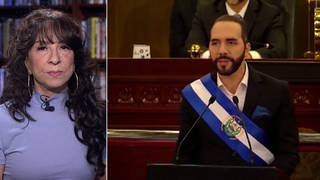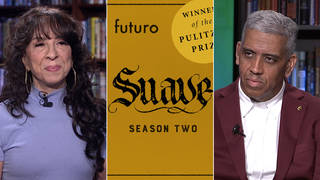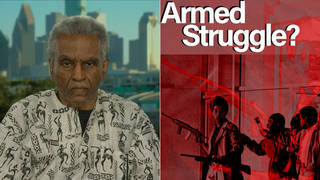
Topics
Guests
- Molly Porziga member of the Prisoner Hunger Strike Solidarity coalition and a spokesperson for Critical Resistance.
- Dorsey Nunnco-founder of “All of Us or None.” He is also the executive director of Legal Services for Prisoners with Children. Nunn was incarcerated from 1971 to 1982 in San Quentin Prison in California. He is one of the mediators between the prisoners on hunger strike and the California Department of Corrections.
- Desiree Lozoyais the niece of an inmate participating in the Pelican Bay hunger strike.
Thousands of inmates in at least 13 prisons across California’s troubled prison system have been on hunger strike for almost two weeks. Many are protesting in solidarity with inmates held in Pelican Bay State Prison, California’s first super-maximum security prison, over what prisoners say are cruel and unusual conditions in “Secure Housing Units.” We play an audio statement from one of the Pelican Bay prisoners and speak to three guests: Dorsey Nunn, co-founder of “All of Us or None” and executive director of Legal Services for Prisoners with Children, and one of the mediators between the prisoners on hunger strike and the California Department of Corrections; Molly Porzig, a member of the Prisoner Hunger Strike Solidarity coalition and a spokesperson for Critical Resistance; and Desiree Lozoya, the niece of an inmate participating in the Pelican Bay Hunger Strike, who visited him last weekend. [includes rush transcript]
Transcript
JUAN GONZALEZ: We turn now to California, where thousands of inmates in at least 11 prisons across the state’s troubled prison system have been on hunger strike for almost two weeks. Many are protesting in solidarity with inmates held in Pelican Bay State Prison, California’s first super-maximum security prison.
The hunger strike began on July 1st in the Pelican Bay’s Security Housing Unit, when inmates began refusing meals to protest what they say is cruel and unusual conditions. Prisoners in the units are kept in total isolation for 22-and-a-half hours a day, a punishment some mental health experts say can lead to insanity and is tantamount to torture.
Democracy Now! obtained a recording of an audio statement that one of the Pelican Bay inmates, Ted Ashker sic, made to his legal team in the secure prison’s Secure Housing Unit, which is referred to as the SHU. You will need to listen closely as he explains his reasons for joining the hunger strike.
TODD ASHKER: The basis for this protest has come about after over 25 years—some of us, 30, some up to 40 years—of being subjected to these conditions the last 21 years in Pelican Bay SHU, where every single day you have staff and administrators who feel it’s their job to punish the worst of the worst, as they’ve put out propaganda for the last 21 years that we are the worst of the worst. And most of us have never been found guilty of ever committing an illegal gang-related act. But we’re in SHU because of a label. And all of our 602 appeals, numerous court challenges, have gotten nowhere. Therefore, our backs are up against the wall.
A lot of us are older now. We have serious medical issues coming on. And we believe that this is our only option of ever trying to make some kind of positive changes here, is through this peaceful protest of hunger strike. And there is a core group of us who are committed to taking this all the way to the death, if necessary. None of us want to do this, but we feel like we have no other option. And we’re just hoping for the best.
JUAN GONZALEZ: That was Todd, not Ted, Todd Ashker, one of the prisoners in Pelican Bay’s Secure Housing Unit who is on hunger strike. California’s Department of Corrections and Rehabilitation spokesperson, Terry Thornton, responded to the hunger strike, saying, quote, “This goes to show the power, influence and reach of prison gangs.” A prison guard told MSNBC that prisoners are kept in the SHU for their own safety.
PRISON GUARD: Inmates that were placed into the SHU housing unit were placed in here, for the most part, because of violence, and that violence could be against other inmates or against officers.
JUAN GONZALEZ: Well, activists who support the strikers dismiss allegations of gang ties. They describe the conditions inside the prison’s highest-security special isolation wing as inhumane.
In May, the federal Supreme Court ruled that California must reduce its prison overcrowding to be able to provide inmates with adequate healthcare. In a five-to-four ruling, the court said conditions in California’s prison system are, quote, “incompatible with the concept of human dignity, causing needless suffering and death.”
Supporters of the hunger strikers protesting these conditions say, as the prisoners continue to refuse food, their health has deteriorated to critical levels.
AMY GOODMAN: For more, we’re joined by three guests. In Oakland, California, we’re joined by Dorsey Nunn, who is co-founder of All of Us or None. He’s also executive director of Legal Services for Prisoners with Children. Nunn was incarcerated from 1971 to '82 at San Quentin. He's one of the mediators between the prisoners on hunger strike and the California Department of Corrections.
Also joining us from the University of California, Berkeley, is Molly Porzig. She’s a member of the Prisoner Hunger Strike Solidarity coalition and a spokesperson for Critical Resistance.
And in Arizona, we’re joined by Desiree Lozoya. She is the niece of a prisoner participating in the Pelican Bay hunger strike. She went to the prison last weekend and visited her uncle.
Desiree, let’s start with you. Tell us what your uncle explained to you, why he’s on hunger strike, and what’s happening at Pelican Bay.
DESIREE LOZOYA: Well, basically, just as Todd had explained in his video clip, they’re just wanting to be treated better. They’re cold. They’re losing weight. And like he had explained, a lot of these prisoners are trying to be—basically gang-labeled. However, there’s nothing to be labeling them for. For instance, my uncle was an interstate transfer to Pelican Bay. He was supposed to be transferred closer to home. However, he was still transferred 17 hours away from us. And then, as soon as they saw a tattoo on his hand, they labeled him right away. Although he has had no write-ups, has gotten into no trouble, they automatically put him in the Ad-Seg, which is now called the new SHU. They are now expanding that. And so, that’s where he sits.
AMY GOODMAN: Because they said the tattoo indicates he’s a member of a gang?
DESIREE LOZOYA: Yes. And the tattoo, he ended up getting when he was a teen. He was only 18 years old when he received the tattoo. It was in no gang affiliation whatsoever.
JUAN GONZALEZ: And we’re also joined by Molly Porzig. She’s a member of the Prisoner Hunger Strike Solidarity coalition. Molly, talk about how this has spread to the rest of the California prison system.
MOLLY PORZIG: Right. So, on the first day of the hunger strike, thousands of prisoners across the state of California, more than 6,600 prisoners that we know of across at least 13 prisons, joined the hunger strike in solidarity with the prisoners at the Pelican Bay SHU and their demands. What’s really significant about that is that people are risking their own lives in joining this action, while being in very similar, or even the same, brutal conditions as the hunger strikers at Pelican Bay. And that speaks to the fact that while this struggle speaks to particular conditions at Pelican Bay and in the SHU, it’s also part of the larger system within California, which was just mentioned that has been condemned by the Supreme Court as inhumane and cruel, due to severe medical neglect and overcrowding.
AMY GOODMAN: I’m wondering, Dorsey Nunn, co-founder of All of Us or None, if you could explain how this strike has spread and how you are negotiating between the prisoners and the prisons.
DORSEY NUNN: I think this strike has spread, just like anybody else that supports injustice. So for them to consider—I heard in your clip when he said the 6,000 people that’s supporting this strike is—demonstrates the influence of gang leaders. I think it demonstrates the need for justice. Just as Martin marched and people followed Martin, people followed Gandhi, people are actually striking because they are being tortured. So I think that this strike has spread because torture is a threatening thing to anybody in the California Department of Corrections.
People are being tortured. Some parts of what I know, as a formerly incarcerated person who have did time within the California Department of Corrections, that they are guilty of torture. It’s like being locked—it’s not “like.” People are being locked up in the bathroom for 23, 24 and 30 years. It may not have been torture maybe the first 30 days or the first 60 days, but when you start getting into multiple decades, then we can call it torture.
When you start extracting information in Pelican Bay or Guantánamo Bay, the purpose is the same. You’re torturing people. And I think under international standards, it can be referred to as that. I think the thing that is troubling, that this thing is happening on the shores of the United States. We never did have to get into renditions if we were going to allow torture in northern California.
JUAN GONZALEZ: And Dorsey—
DORSEY NUNN: So this thing is spreading.
JUAN GONZALEZ: Dorsey Nunn, what’s been the response of prison officials or government officials? Have they attempted to negotiate or mediate through you or with the inmates?
DORSEY NUNN: I think that we entered discussions. I wouldn’t necessarily call it “negotiating.” We entered discussions, you know. So I guess if I was in a cage with a 600-pound gorilla, you couldn’t necessarily call it a dance.
AMY GOODMAN: And where do you—
DORSEY NUNN: You know, so I—you know, what you—
AMY GOODMAN: Go ahead, Dorsey.
DORSEY NUNN: You know, what brings me into this studio this morning at 5:00 in the morning is that I’m scared people are going to start dying. You know, the only model that these guys got left is the model of Bobby Sands and the Irish strike. That’s their model. So these guys—
AMY GOODMAN: Explain what you mean by that.
DORSEY NUNN: You know, somebody needs to think about what would drive human beings—yes.
AMY GOODMAN: Dorsey, you’re talking about—you’re talking about fasting to death, if you’re talking about Bobby Sands.
DORSEY NUNN: Yeah, that’s what they’re talking about. And that’s what they’ve been like—that’s what I’m frightened of. So what brings me into your studio is, I think they’re betting on the compassion of people who live in the state of California, people who live in the United States. And what’s frightening to me is that I don’t know if that compassion really exists.
MOLLY PORZIG: I mean, just to add to that, to back up to the question of what has the response of officials been, I mean, it’s very, very clear that the CDCR is more than willing, if not wanting, people to start dying. They want this to go away quickly and quietly. They pride itself on Pelican Bay being the end of the line, not only for people in California, but to be a model for the United States, and really the world, in terms of how to repress political organizing and resistance and any sort of defiance to any sort of establishment.
And I think that, you know, what the challenge is for supporters outside of prison is that we need to be tirelessly working at, in a very urgent way, taking the risks that we can to match the courage of these hunger strikers, because, like Dorsey is saying, people—it’s not just that we’re afraid of in a few weeks people dying. People are getting to that point now. And we need to be acting more. You know, historically, people have used civil disobedience to prevent mass death. And that’s exactly the moment that we’re in right now. That’s exactly what these hunger strikers and thousands and thousands of prisoners across the state of California are doing. Some prisoners at Ohio State Penitentiary are also joining this. You know, so this is really, really huge.
AMY GOODMAN: We have to leave it there.
MOLLY PORZIG: And if people start dying, if it gets to that point—OK.
AMY GOODMAN: We have to leave it there, but I thank you so much, all, for being with us. We will certainly follow this hunger strike. We’ve been joined by Dorsey Nunn, co-founder of All of Us or None, by Molly Porzig with Critical Resistance, and thank you to Desiree Lozoya, who joined us from Arizona.











Media Options